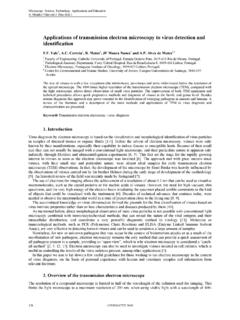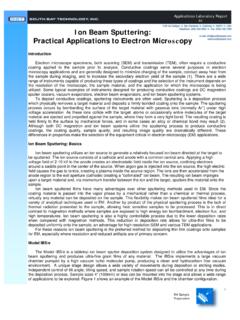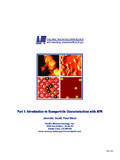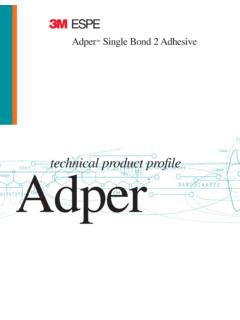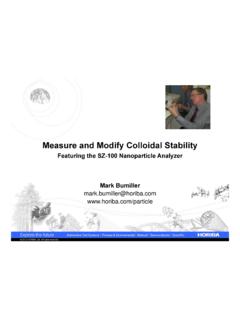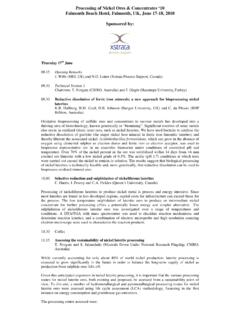Transcription of Magnification Standards for SEM, Light, or Scanning Probe ...
1 Magnification Standards for SEM, light , or Scanning Probe microscopy Joseph D. Geller Geller Micro nalytical Laboratory, 426e Boston St., Topsfield, MA (USA) 01983-1216 For some applications it is important to know the accuracy of macro and micro structures that are imaged using microscopy . It is especially important if those measurements are in some way related to product quality or for research purposes. For other applications it may not be important to know the accuracy but the company s quality system may require it. Magnification Standards used for ac-curacy determination are available from many sources. If the microscopy laboratory is under ISO (International Standards Organization) 9000 or 17025, the calibration Standards should be obtained either from a national laboratory, such as NIST (National Institute for Science and Technology in the or NPL (National Physical Laboratory) in the , or as a reference material traceable to a national laboratory.)
2 Those traceable Standards should be obtained from a ISO-17025 accredited laboratory since they must have been audited by experts able to determine the laboratory s compe-tency and their uncertainty budget. Although commonly used in the past companies self certifying traceability is no longer acceptable. What is Magnification ? Simply stated it is the ratio of the image size to the object size. Images can be generated by any type of microscope, from a low power stereo at 3X or a transmission electron microscope or Scanning Probe microscope at 1 X 106 X. Of course, there are some details about which we must be concerned. Care should be taken to use the same dimensional units for the image and object size calculation. The image can be hard copy (a print), displayed on a viewing screen (a CRT, projection screen or TV) or projected onto a reticle mounted in an eyepiece on an optical mi-croscope. If hard copy is used the image size should be measured with a ruler [1] of known accu-racy ( traceable).
3 Measurement on a viewing screen is more difficult due to parallax errors. If a reticule is used its dimensional uncertainty should be known and, of course, should be traceable. International Standards . It is difficult to make some kinds of measurements without sacrificing accuracy. Those with the highest accuracy use the concept of pitch . In the E766-98 Standard Practice for Calibrating the Magnification of a Scanning Electron Microscope [2] pitch is defined as the separation of two similar structures, measured as the center-to-center or edge-to-edge distance. For light microscope calibration the ASTM E1951-98 [3] is applicable. Both guides cover methods for calculating and calibrating microscope magnifications. For E1951 photographic magnifications, video monitor magnifications, grain size comparison reticules are covered. Since the relationship between true Magnification and magnifications indicated on the SEM or other microscope readout may be different at different magnifications, keV, working distance, tilt, etc.
4 , these practices must be applied to each condition for which the true Magnification is desired. ISO has a standard in de-velopment, 16700 Microbeam analysis -- Scanning electron microscopy -- Guidelines for Calibrat-ing Image Magnification . As mentioned, pitch is the separation of similar structures using repeating edge or center locations. This measurement is unaffected by illumination conditions (numerical aperture, off-axis illumina-tion, etc.) or electron signal types ( transmitted, secondary or backscattered electrons, and keV). Examples of pitch type specimens would be the markings on a ruler or stage micrometer or a grat-ing periodicity. Those outside the definition would be sphere diameters or the width of a line or space. For these non-pitch measurements edge location uncertainty must be determined. Available certified reference materials: Certified reference materials have values which are measured by a procedure which establishes its traceability to an accurate realization of the unit in which the property values are expressed, along with their uncertainties.
5 The standard used for cali-bration must have dimensions within the size range needed for measurement. Measurements which are outside this range cannot be considered accurate. The calibration standard must have pitch fea-tures with dimensions of at least 5 mm, or larger, and at m, or smaller. It would be a misuse of the standard to calibrate >5 mm or < m features. The recently discontinued NIST SRM-484 SEM Magnification standard had line spacing from to 5 m. Its usable Magnification range was 1000X to 20,000X. The use of this standard at 20,000X does not justify making measurements un-der m since linearity and distortion in the imaging system cannot be confirmed. As such, it would be inappropriate to measure a m feature (5 mm at 20,000X) or a 6 m feature (6 mm at 1000X . The new SRM-2800 from NIST has one dimensional rulings from 1 to 5,000 m. ASTM E766 states that a Magnification standard should have pitch patterns in both X and Y direc-tions such that sample or raster need not be rotated.)
6 Of course, this applies to all forms of micros-copy. SEM-484 had features in only one axis. National Physical Laboratory [5] has available two dimensional gratings on SEM stubs with spacings of 2160, 100 and lines per mm. Standards available from private companies may be certified reference materials. An example is the MRS-4 [6] which is made under ISO-17025 accreditation. It has patterns in X and Y with an effective cali-bration range from 10X to 200,000X (minimum pitch is m), see below. Grid Standards and holographically generated patterns often give average average frequencies rather than individual spacings. This is not suitable for microscopy which images specific structures. Consideration should also be given to the standard s cleanliness and recertification interval, which for non-perishable materials must be determined (per ISO-17025) by the quality department and not the supplier. Per-forming work to a known uncertainty is important and achievable with the proper equipment and knowledge.
7 References: [1] Micro-ruler , from Geller MicroAnalytical Laboratory, Topsfield, MA 01983 (USA). [2] American Society for Standards & Materials, Consho-hocken, PA. E766-98 Standard Practice for Calibrating the Magnification of a Scanning Electron Microscope. [3] American Society for Standards & Materials, Conshohocken, PA. E1951-02 Standard Guide for Calibrating Reticules and light Micro. Magnifications. [4] International Standards Organization, Geneva, Switzerland, DIS (Draft in Standard) 16700 Mi-crobeam analysis - Scanning electron microscopy - Guidelines for Calibrating Image Magnification . [5] National Physical Laboratory, Teddington, , see [6] MRS-4, Geller MicroAnalytical Laboratory, Topsfield, MA 01983 (USA).

